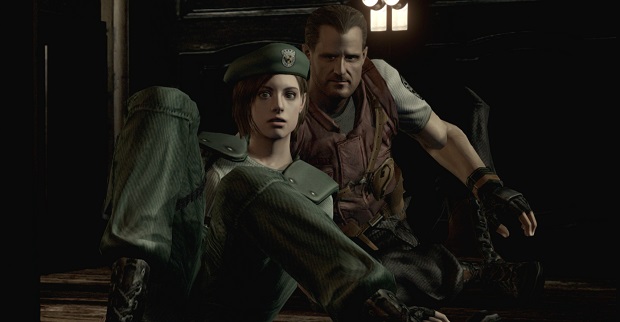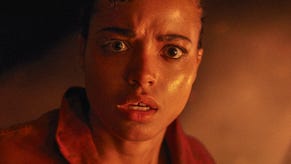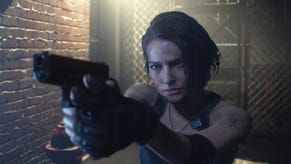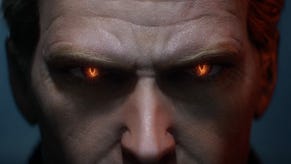Wot I Think: Resident Evil HD Remaster
REmade, REmastered, REvisited
Originally released in 1996 and remade in 2002, Resident Evil is one of the giants of survival horror. This new release is the first appearance of the remake on PC and it comes hot on the heels of director Shinji Mikami's return to survival horror. Far more than an object of historical curiosity, it's a smartly designed and claustrophobic masterpiece.
This is the third version of Resident Evil I've played and I have a stronger appreciation for the game every time I encounter it. I found the original release disappointing, following months of hype that had inflated my expectations unrealistically. Horror films have been my cathartic companions from a (perhaps too) early age and Resident Evil looked like it might be the first blockbuster game to capture the terror of Romero's Dead trilogy.
Unwilling to trouble myself with the facts, I'd absorbed the handful of screenshots published in magazines and dreamed up a game around them. The foundation of my beliefs - and much of Resi's actual design - was Alone in the Dark, which had plucked at the delicate tissues of my pineal gland, chasing away sleep and inducing the weird joy that comes from fear. I expected a more through simulation of the zombie-infested mansion and pictured my character barricading windows and doors, collecting supplies to treat wounds and stave off infection.
It wasn't to be. Resident Evil's mansion is a giant puzzle box, the eventual unlocking of which requires backtracking and inventory management that brings to mind another Z Word - Zork. Gruesome it may have been, but Resident Evil's abstract puzzles and camp dialogue disappointed me. I wanted tactical survival and psychological scares, not an elaborate item hunt with a narrative wrapping that could have passed for a Sci Fi Channel original.
By the time the Gamecube remake rolled around, I'd discovered the Silent Hill series and thought of Resident Evil as the slightly embarrassing uncle of the survival horror genre rather than the venerated godfather. The conspiracies and corporations of the sequels and spin-offs all seemed to confirm that the plot had become the daft, convoluted mess that the first game hinted at. I'm always dismayed by the presence of the culty nonsense in Silent Hill games but it's barely an issue at all next to Resi's cast of cartoon action heroes and plastic villains.
The moment a Resident Evil game presumes I have an interest in or knowledge of the series' tedious backstory, it's in danger of losing me. A decent sequence, set piece or scare will pull me back in easily enough, but I have about as much interest in the fiction as I do in the awful films.
Perhaps that's why revisiting the first game again has been such a splendid experience. The main plot is almost as tight and controlled as the setting, owing as much to mad scientist B-movie narratives as to comic book conspiracies. And then there are the subplots, including one added to the 2002 remake that is the game's standout dose of nightmare fuel. More on that later.
First of all, a brief re-evaluation of the game's design. It entirely fails to be the impossibly advanced simulation I wanted and expected as a teenager, but it is a masterpiece. The layout of the mansion and its surroundings is the foundation, and as the map turns from black to red to green, new routes are opened and mysteries are revealed. It's a crowded location, retaining its claustrophobic quality even as its outer edges and darkest depths are discovered. Almost every scene contains something of importance, with even seemingly empty corridors and trails usually offering some challenge rather than simply acting as a link from one puzzle to the next.
Everything in the game relies on careful management, whether it's combat and the handling of ammunition and healing items, or the plotting of a route from a safe room to an obstacle. It's a slow game but impeccably paced, almost always offering one or more obvious threads to pull on. Apply just the right amount of pressure - the right object in the right place - and the mansion starts to unfold and unravel.
Following those threads isn't always the most satisfying experience. The game's most noticeable failing is a lack of direction. There aren't always enough hints, textual or visual, as to what the next step should be and even though this is my third time playing through the game, I occasionally felt like I'd hit a brick wall. The first couple of hours can be particularly confusing, as several possibilities seem to open up simultaneously but then transform into dead-ends, with emphasis on the dead.
Boss fights can be frustrating because, on the whole, they operate on the same wavelength as the puzzles. Even though they look like they involve a steady hand and quick feet, they're mostly about bringing the correct equipment to the fight. All combat involves calculations rather than reflexes. I don't ask myself if I have the skill to take down a zombie, I ask myself if I have the necessary resources.
I wonder how often I'm likely to venture down a certain corridor, figuring out whether it's worth expending the ammunition necessary to dispatch the zombie that is groaning and gurning in the shadows. I can sneak past but every once in a while the thing manages to grab me and bite chunks out of my neck. That wound will need to be healed, and herbs and first aid sprays become increasingly rare. But ammunition is limited as well - every bullet fired into a zombie's fetid face is a bullet that won't be available when facing one of the huge mutants that can't be bypassed.
The save system and limited inventory space irritated me when I first played the game but they're fundamental to the design. The physically impossible item boxes, which apparently allow the player character to store all of their stuff in a pocket dimension, ensure that the player plans ahead. On this most recent playthrough, Resi became a cooperative experience - one person with a joypad, the other drawing copies of the maps and annotating them, making notes and linking inventory items to locations. The adventure game logic of the mansion and its puzzles happily translated into a method of playing that reminded me of long nights solving Sierra games with my sister decades ago.
As far as the story goes, it's as naff as ever, although thankfully without the meandering mythology of the later games. I find it enjoyable in the same way that I find Roger Corman's Poe adaptations enjoyable, with the occasional delicious thrill of fear alongside the creaking backdrops and splatters of gore. The horrific highlight is the Lisa Trevor subplot, which made its debut in the Gamecube remake and remains as a jarring and effective spike of terror.
Genuinely unsettling in a way that is perhaps even more startling because of the hammy context, it's as if you've spent an hour and a half watching Vincent Prise seasoning and then devouring the scenery, and suddenly the last ten minutes of Rec happen. I'll say no more.
That's the only 'new' thing though and even that won't be new to anyone who played the first iteration of the remake. So what is the particular appeal of this version? It's attractive for the most part, although some textures look almost as old as the original game and stand out next to their retouched neighbours. I was relieved to see that the increased resolution hasn't entirely removed the VHS quality of the graphics. It looks beautiful but hasn't lost its grainy, dirty quality, although that does mean the graphical update isn't quite as obvious as some might hope.
Partly the appeal IS nostalgic but this hasn't been a case of revisiting a shiny version of a game I already loved. Over time, I've come to appreciate the intricacies of design and where I might once have been disappointed by the occasional silliness and inconsistent atmosphere, I'm now far more interested in picking apart the efficiency and economy of the map. I wish there was more information about the design and development, but apart from a digital artbook preorder bonus, it's sadly lacking in extras - I'd like to have seen a stack of unlocks digging through the history of the game but there's nowt except difficulty levels and a 'gallery' of videos.
Those disappointments aside, replaying has been something of a revelation for me. This new release may not be as bold and striking as the remake seemed when it first appeared but I've been surprised by the enduring quality of the mansion. Playing through into the early hours of the morning almost every night last week led to a hugely entertaining collaborative conversation, with occasional breaks to shudder at a barely remembered horror or to giggle at a ludicrous line of dialogue. I've been known to dismiss the early games in the series, seeing Resident Evil 4 as a new beginning that erased the sins of the past, but I've spent the weekend trying to track down my copy of Resident Evil 2 so that I can get a second fix.
It may not be perfectly tuned but Resident Evil is as pure an expression of the survival horror genre as you're likely to find (although the sequel might well be its match, I'll reconsider if I ever do find that copy). If you've never played the remake at all, it's worth visiting the mansion again just to meet Lisa Trevor, and if you've never played Resident Evil at all, now's the time. It's a slice of cultural history that has exerted enormous influence but has mostly avoided direct imitation. When something is this well-crafted, the flaws of a counterfeit are obvious.
Resident Evil Remastered is out tomorrow.













